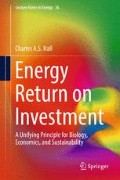Abstract
The principal energy sources in antiquity were all derived directly from the sun: human and animal muscle power, wood, flowing water, and wind. About 300 years ago the industrial revolution began. It brought an exponential increase in the energy available to humans to do economic work. This revolution began with stationary wind-powered and water-powered technologies, which were subsequently supplemented and replaced by fossil hydrocarbons (fossil meaning old): coal in the nineteenth century, oil since the twentieth century, and now, increasingly, natural gas. The global use of hydrocarbons for fuel by humans has increased nearly 800-fold since 1750 and about 12-fold in the twentieth century. The enormous expansion of the human population and the economies of most nations in the past 100 years have been facilitated by a commensurate expansion in the use of fossil fuels.
Access this chapter
Tax calculation will be finalised at checkout
Purchases are for personal use only
References
Ayres, R.U., J.C.J.M. Van den Bergh, D. Lindenberger and B. Warr. 2013. The underestimated contribution of energy to economic growth. Structural Change and Economic Dynamics 27, 79–88.
Cook, E. 1976. Man, Energy, Society, W. H. Freeman. San Francisco.
Hall, C.A.S. and J.-Y. Ko. 2005. The myth of efficiency through market economics: a biophysical analysis of tropical economies, especially with respect to energy, forest and water. pp. 40–58, in Bonell, M., and L.A. Bruijnzeel (Eds.), Forests, Water and People in the Humid Tropics: Past, Present and Future Hydrological Research for Integrated Land and Water Management. Cambridge University Press. Cambridge, UK. 944 pp.
Hall, C.A.S., D. Lindenberger, R. Kummel, T. Kroeger, and W. Eichhorn. 2001. The need to reintegrate the natural sciences with economics. BioScience 51: 663–673.
Hall, C., and K. Kent 2012. Energy and the Wealth of Nations. Understanding the Biophysical Economy. Springer, N.Y.
Heinberg, R. and D. Fridley 2016. Our renewable future: laying the path for one hundred percent clean energy. Island Press, Washington, D.C.
International Energy Agency. 2016. Fossil fuel subsidy database. Available online: http://www.worldenergyoutlook.org/resources/energysubsidies/fossilfuelsubsidydatabase/. Accessed on 10 August 2016.
Jevons, W.S. 1865. The coal question: An inquiry concerning the progress of the nation, and the probable exhaustion of our coal mines, in Flux, A.W. 1965. Reprints of economic classics. New York: Augustus M. Kelley.
Kaufmann, R.K. 2004. The mechanisms for autonomous increases in energy efficiency: a cointegration analysis of the US energy/GDP ratio. Energy Journal 25: 63–86.
Leontief, W.W. 1982. Academic Economics. Science 217: 104–107.
Maggio, G., and G. Cacciola. 2012. When will oil, natural gas, and coal peak? Fuel 31(98): 111–123.
Mohr, S.H., J. Wang, G. Ellem, J. Ward, and D. Giurco. 2015. Projection of world fossil fuels by country. Fuel 1(141): 120–135.
Nadel, S., N. Elliott, and T. Langer. 2015. Energy efficiency in the United States: 35 years and counting report E1502 American council for an energy-efficient economy. Washington, DC.
Sekera, J.A. 2016. The public economy in crisis: A call for a new public economics. Springer Briefs in Economics. NY.
Smil, V. 2007. Light behind the fall: Japan’s electricity consumption, the environment, and economic growth. Japan Focus, April 2.
Tharakan, P.J., T. Kroeger, and C.A.S. Hall. 2001. Twenty-five years of industrial development: a study of resource use rates and macro-efficiency indicators for five Asian countries. Environmental Science & Policy 4: 319–332.
Author information
Authors and Affiliations
Corresponding author
Rights and permissions
Copyright information
© 2017 The Author(s)
About this chapter
Cite this chapter
Hall, C.A.S. (2017). Fossil Fuels. In: Energy Return on Investment. Lecture Notes in Energy, vol 36. Springer, Cham. https://doi.org/10.1007/978-3-319-47821-0_9
Download citation
DOI: https://doi.org/10.1007/978-3-319-47821-0_9
Published:
Publisher Name: Springer, Cham
Print ISBN: 978-3-319-47820-3
Online ISBN: 978-3-319-47821-0
eBook Packages: EnergyEnergy (R0)

